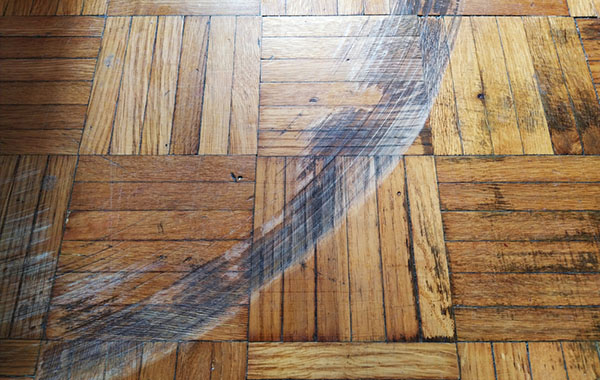Wood floors can instantly elevate the aesthetic appeal of any space, adding warmth and sophistication. However, over time, these gorgeous floors may fall victim to the wear and tear of daily life, leaving behind unsightly deep scratches. While this may seem like a cause for despair, fear not! With a little know-how and some simple tools, you can easily restore your wood floor to its former glory. In this guide, we will explore step-by-step techniques on how to fix deep scratches on wood floors, allowing you to regain the beauty of your flooring and bring life back into your living space.
Whether it’s a result of furniture movement, pet claws, or accidental mishaps, deep scratches on wood floors can be an eyesore that dampens the overall appeal of your home. But fret not, as there are effective solutions to remedy this common issue. In this comprehensive guide, we will delve into the world of wood floor restoration, equipping you with the knowledge and skills needed to banish those deep scratches and restore your floor’s natural beauty. From assessing the severity of the scratch to selecting the right tools and materials, we will walk you through each step of the process, ensuring that you are well-prepared to tackle this task with confidence and precision. So, if you’re ready to bid farewell to those unsightly blemishes on your wood floor, let’s dive in and discover the secrets to a successful restoration!
- Assess the damage by cleaning the scratched area with a soft cloth.
- If the scratch is shallow, apply a wood floor cleaner and gently rub it in with a soft cloth.
- For deeper scratches, use a wood filler that matches the floor color. Apply it with a putty knife, smooth it out, and let it dry.
- Once the filler is dry, sand it lightly with fine-grit sandpaper until it is smooth and level with the floor.
- Finish by applying a wood floor polish or wax to restore shine and protect the repaired area.

How To Fix Deep Scratches on Wood Floor
In this article, we will guide you through the step-by-step process of fixing deep scratches on a wood floor. Whether your wood floor has suffered from furniture movement, pet claws, or accidental damage, these simple techniques will help restore its beauty and make it look as good as new.
1. Assess the Damage
The first step in fixing deep scratches on a wood floor is to assess the extent of the damage. Inspect the scratched area carefully to determine if it is a surface scratch or a deep gouge. Surface scratches can often be remedied with a simple touch-up, while deep scratches require more intensive repair.
If the scratch is deep enough that it exposes the bare wood, you will need to follow the steps outlined below to repair it. However, if it is a surface scratch, you may be able to fix it with a wood floor cleaner and a touch-up marker.
2. Gather the Necessary Materials
Before you begin the repair process, make sure you have all the necessary materials on hand. This will save you time and frustration during the repair process. Here’s a list of items you will need:
- Wood filler
- Putty knife
- Sandpaper (medium and fine grit)
- Wood stain (matching the color of your floor)
- Clean cloth or sponge
- Protective finish (polyurethane or varnish)
- Paintbrush
3. Prepare the Scratch for Repair
Before you can fill the deep scratch, you need to prepare the area. Start by cleaning the scratch using a soft cloth or sponge and a mild detergent. Make sure to remove any dirt or debris from the scratch.
Next, use a medium-grit sandpaper to gently sand the scratched area. This will help smooth out any rough edges and create a clean surface for the filler. Be careful not to sand too aggressively, as you don’t want to damage the surrounding wood.
4. Fill the Scratch with Wood Filler
Once the scratch is clean and sanded, it’s time to fill it with wood filler. Take a small amount of wood filler on a putty knife and apply it to the scratch, making sure to fill it completely. Smooth out the filler using the putty knife, removing any excess.
Allow the wood filler to dry completely, following the manufacturer’s instructions. Once dry, use fine-grit sandpaper to gently sand the filled area until it is flush with the surrounding wood. This will create a seamless finish.
5. Stain and Finish the Repaired Area
To ensure the repaired area matches the rest of the wood floor, apply a matching wood stain. Use a clean cloth or sponge to apply the stain to the filled scratch, following the grain of the wood. Allow the stain to dry according to the manufacturer’s instructions.
Finally, protect the repaired area by applying a protective finish, such as polyurethane or varnish. Use a paintbrush to apply a thin, even coat of finish to the repaired section and let it dry completely. Repeat this step if necessary to achieve the desired level of protection.
6. Maintain and Prevent Future Scratches
Once the repair is complete, it’s important to maintain your wood floor properly to prevent future scratches. Place felt pads under furniture legs, use rugs or mats in high-traffic areas, and avoid dragging heavy objects across the floor.
Regularly clean your wood floor using a soft broom or vacuum cleaner with a brush attachment. Avoid using harsh chemicals or abrasive cleaners that can damage the finish. Instead, use a wood floor cleaner recommended by the manufacturer.
7. Seek Professional Help if Needed
If you are unsure about your ability to fix deep scratches on your wood floor or if the damage is extensive, it’s best to seek professional help. A professional floor refinisher will have the expertise and tools to repair and restore your wood floor effectively.
By following these steps and taking proper care of your wood floor, you can keep it looking beautiful and scratch-free for years to come.
Frequently Asked Questions
Here are some commonly asked questions about how to fix deep scratches on wood floors:
Q: What causes deep scratches on wood floors?
There are several factors that can cause deep scratches on wood floors. These include dragging heavy furniture across the floor, moving appliances without proper protection, pets with long nails, and even high heels or shoes with sharp edges. It’s important to be cautious when moving objects or walking on wood floors to prevent deep scratches.
To avoid future scratches, you can use furniture pads or felt on the bottom of furniture legs, trim your pet’s nails regularly, and encourage guests to remove their shoes before walking on the floor.
Q: Can I fix deep scratches on my wood floor myself?
Yes, you can fix deep scratches on your wood floor yourself with the right tools and materials. However, the extent of the damage and the type of wood floor you have will determine the best method for repair. For minor scratches, you can use wood fillers or touch-up pens to fill in the scratches and blend them with the surrounding area.
For deeper scratches, you may need to sand down the damaged area and then apply a matching stain or finish to restore the appearance of the wood. It’s important to follow the manufacturer’s instructions and take proper safety precautions when undertaking any repair work on your wood floor.
Q: What tools and materials do I need to fix deep scratches on a wood floor?
To fix deep scratches on a wood floor, you will need a few essential tools and materials. These include sandpaper or a sanding block, wood filler or putty, a putty knife or scraper, a stain or finish that matches your floor, a clean cloth or sponge, and a soft-bristled brush. You may also need a vacuum or broom to clean the area before and after the repair.
It’s important to choose the right type of sandpaper or sanding block for your wood floor to avoid causing further damage. Additionally, make sure to select a wood filler or putty that matches the color and grain of your floor for a seamless repair.
Q: How do I prepare the area before fixing deep scratches on a wood floor?
Before fixing deep scratches on a wood floor, it’s important to properly prepare the area to ensure a successful repair. Start by cleaning the scratched area using a vacuum or broom to remove any dirt or debris. Then, use a clean cloth or sponge dampened with water to wipe the surface and remove any remaining residue.
If the scratched area has any wax or polish buildup, you may need to use a gentle wood floor cleaner to remove it. Allow the area to dry completely before proceeding with the repair process. This will ensure that the wood filler or stain adheres properly and provides a seamless finish.
Q: Can I prevent deep scratches on my wood floor?
While it’s not always possible to prevent all scratches on a wood floor, there are steps you can take to minimize the risk of deep scratches. One effective way is to place rugs or mats in high-traffic areas, such as entryways or hallways, to protect the floor from heavy foot traffic or furniture movement.
Using furniture pads or felt on the bottom of furniture legs can also help prevent scratches when moving or rearranging furniture. Regularly trimming your pet’s nails and encouraging guests to remove their shoes can also reduce the chances of deep scratches. Additionally, avoiding dragging or sliding heavy objects across the floor can help maintain its pristine condition.

Taking care of your wood floor is essential to maintain its longevity and aesthetic appeal. By implementing preventative measures such as using furniture pads, regularly cleaning and waxing the floor, and addressing minor scratches promptly, you can minimize the chances of deep scratches occurring. However, in the unfortunate event that deep scratches do mar the surface of your wood floor, it is important to address them promptly to prevent further damage and maintain the value of your investment. With a little patience, effort, and the tips provided in this article, you can restore your wood floor to its former glory and enjoy its beauty for years to come.
- How to Install Vertical Wood Siding - April 23, 2024
- How to Build a Wooden Picnic Table - April 23, 2024
- How to Dye Wood Minecraft - April 23, 2024